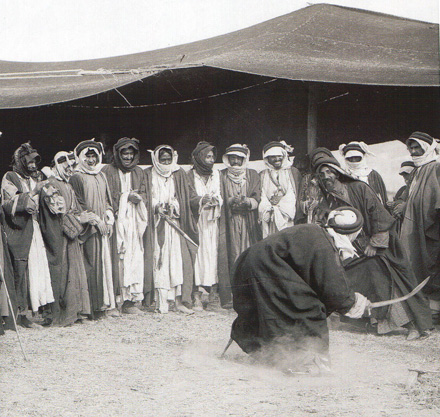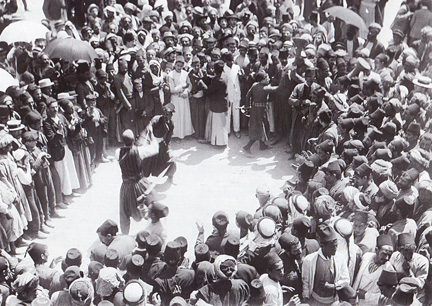
Sword dance at a Bedouin wedding in Palestine, early 1900s; Rowe 2010, opposite p. 116
We hear so much about the political turmoil between Palestinians and Israelis that the traditional culture and its transformation are all but forgotten. Bombs continue to go off or be dropped, settler slabs destabilize the opportunity for a variety of people to live together, hawks and doves flitter away in a rhetorical fog. Yet there is movement, especially in dance. Nicholas Rowe, a choreographer and dancer from Australia has recently published a moving portrait of the changing dance tradition among Palestinians, with a focus on how dance reflects political stalemate and obstacles. This is his Raising Dust: A Cultural History of Dance in Palestine (London: I. B. Tauris, 2010).
A brief description of the book is provided by the publisher:
Dance in Palestine has a history as complex and contentious as the land itself. Whether dismissed as bacchantic madness by Bible tourists in the 19th Century, revived and glorified by Zionists, Pan-Arabists and Palestinian Nationalists in the 20th Century, or rejected by Islamic Reformists in the 21st Century, dance in Palestine has a rich and elusive story that remains to be told. ‘Raising Dust’ traces one dancer’s journey into Palestine’s past and present. Through historical archives, the memories of dancers of yesteryear and into today’s vibrant performing arts scene, Nicholas Rowe shows how dance has acted as a barometer of social change, a forum for debate and a means of expressing forbidden ideas. Far from apolitical, this most physical of art forms has often defined the political mood of the day. Sumptuously illustrated, the author provides a unique, rare and compelling cultural history of dance in Palestine
But I suggest you pick up a copy and read it for yourself. In addition to the narrative of a vibrant cultural tradition there are numerous illustrations, like the historical photographs above and below.

Men dancing with swords in celebration in Palestine, late nineteenth or early twentieth century; Rowe 2010, opposite p. 116
.